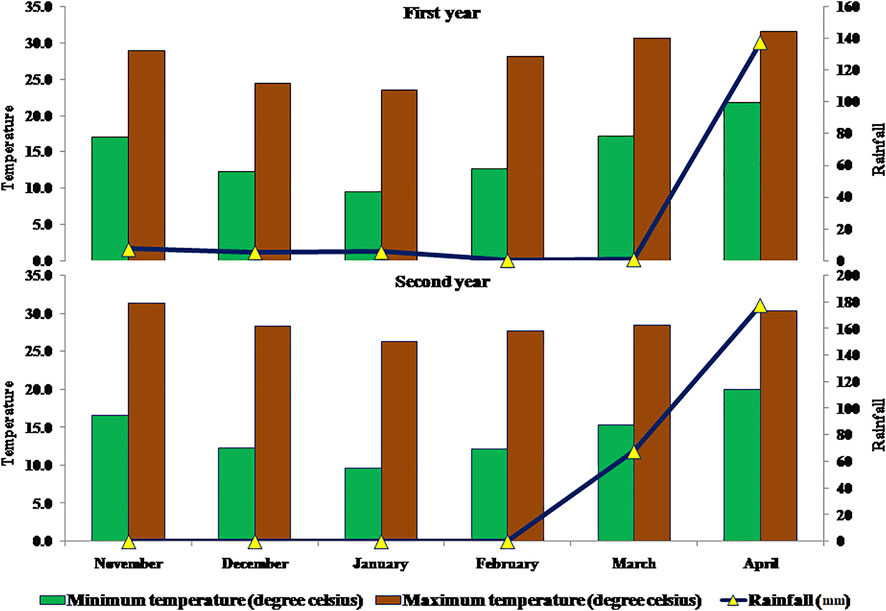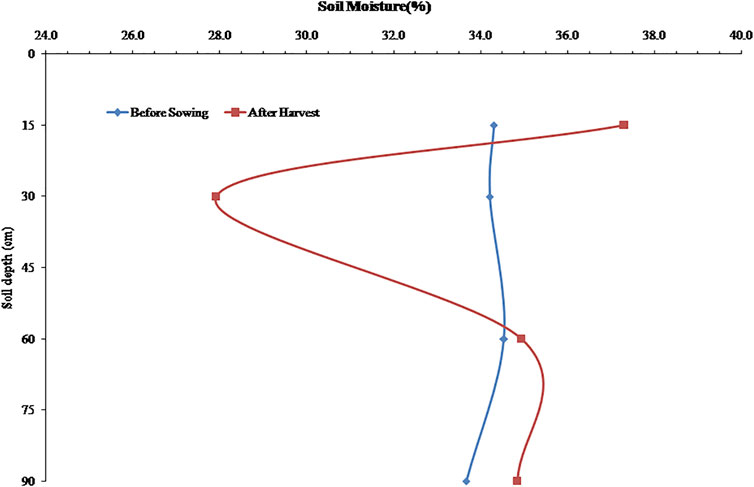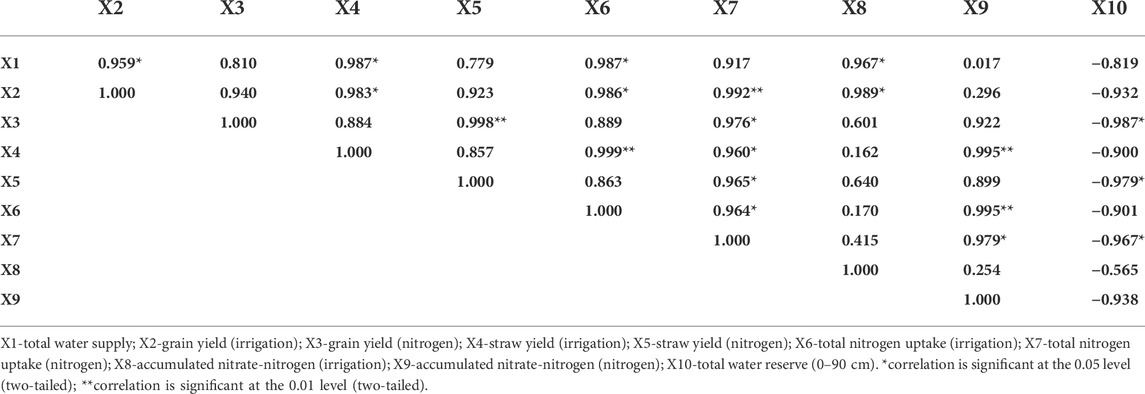- 1Department of Soil Science and Agricultural Chemistry, Uttar Banga Krishi Viswavidyalaya, Cooch Behar, India
- 2School of Agriculture, Seacom Skills University, Birbhum, India
- 3Department of Plant Pathology, Uttar Banga Krishi Viswavidyalaya, Cooch Behar, India
- 4Indian Council of Agricultural Research (ICAR)-National Academy of Agricultural Research Management, Hyderabad, India
- 5Bihar Agricultural University, Bhagalpur, India
- 6Punjab Agricultural University, Ludhiana, India
- 7ICAR-Indian Institute of Rice Research, Hyderabad, India
- 8ICAR-Indian Institute of Soil Science, Bhopal, India
- 9KVK, Balumath Latehar (BAU), Jharkhand, India
- 10Veer Kunwar Singh College of Agriculture, Dumraon, India
- 11Division of Seed Science and Technology, ICAR- Indian Agricultural Research Institute, New Delhi, India
- 12ICAR-National Rice Research Institute, Cuttack, India
Due to the introduction of zero-till wheat in the Indo-Gangetic plains (IGP) in India, irrigation and fertilizer nitrogen (N) management needs to be modified from that followed under conventionally tilled fields. A field experiment was conducted to study the effect of irrigation and N levels on yield and N uptake by zero-till wheat, fertilizer N-use efficiency, and distribution of nitrate-N (NO3-N) in a soil profile under zero-till conditions in an acidic alluvial soil of the eastern IGP. The experiment was laid out in a split-plot design with four levels of irrigation as main plots (I0-no irrigation, rain-fed, I1-122 mm in one irrigation at 21 days after sowing (DAS), I2-263 mm in two irrigations at 21 and 42 DAS, and I3-386 mm in three irrigations at 21, 42, and 84 DAS) and 4 N levels [0 (N0), 60 (N1), 120 (N2), and 150 (N3) kg N ha−1] as subplots. Grain and straw yields were significantly higher at the irrigation level-I2 and 120 kg N ha−1-N2 over the control (I0 and N0) and were at par with the highest applied levels of irrigation and N (I3 and N3). The nitrogen uptake by wheat followed a trend similar to yield for irrigation levels; however, it increased significantly up to 150 kg N ha−1. After the harvest of wheat crop, more NO3-N was observed in the 60–90 cm subsurface soil layer than in the surface 0–15 cm and/or 15–30 cm and 30–60 cm subsurface soil layers. The highest NO3-N concentration was recorded in the treatment I2N2. Accumulation of NO3-N in the soil increased up to irrigation levels I2 and with increasing doses of fertilizer N application. Combined applications of irrigation and N had a positive and significant influence on agronomic efficiency (AE) and apparent N recovery (ANR) but had no significant effect on physiological efficiency (PE). This study suggests that an appropriate combination of irrigation and N levels in zero-till wheat can lead to not only high-yield levels and N-use efficiency but also adequately control NO3-N leaching under acidic alluvial soils in the eastern IGP.
Introduction
The Indo-Gangetic alluvial plains (IGP) of India with an area of more than 28 million hectares are an environmentally sensitive region where rice and wheat grown in an annual rotation constitute the dominant cropping system. The landscape, hydrology, and fertility status in the region are affected by climate change and population pressure (Saini, 2008). The IGP is divided into three parts: western, middle, and eastern; but for wheat, the eastern part is the least productive region due to a low soil fertility status and uneven distribution of rainfall coupled with lack of adequate irrigation which lead to low cropping intensity and farm productivity (Sekar and Pal, 2012; Bhatt et al., 2016). Wheat productivity in the eastern IGP can be improved if farmers agree to plant wheat just after harvesting the main rice crop and optimally use the residual soil moisture. Traditionally, farmers in the region cultivate either wheat or potato after harvesting rice but with conventional tillage, which results in the loss of soil moisture and low crop productivity. The use of zero tillage in wheat could conserve more soil residual moisture and thus support better wheat growth (Ding et al., 2021). Adoption of zero tillage in wheat cultivation could also save input cost, fuel consumption, and irrigation. The water-use compared to conventional cultivation is well documented (Yadav et al., 2002; Yadav et al., 2005). In western IGP, under zero tillage wheat sowing, both yield and net returns were 12% and 25% greater than conventional cultivation, respectively (Prem et al., 2018).
Water is the main limiting factor in wheat production. The irrigation scheduling and frequency are key factors to help farmers in increasing wheat yield and saving water, especially in light-textured soils (Awaad and Deshesh, 2019). Nitrogen (N) is one of the most important plant nutrients which directly affects wheat production and also contributes most to environmental degradation. It is optimally required for wheat throughout the growing season for supporting both vegetative and reproductive growth stages (Jat et al., 2014). Significant synergistic effects between N application and irrigation have also been observed in wheat (Geesing et al., 2014). Water utilization improves with an optimal supply of N resulting in higher N-use efficiency (NUE) in wheat (Luis et al., 2005; Sepaskhah et al., 2006; Rasmussen et al., 2015). Both NUE and extent of losses of N from the soil–plant system are important issues in any region. In general, nitrate is lost through leaching and may even pollute groundwater bodies with excessive N application to cereals like wheat (Bijay-Singh and Craswell, 2021). The magnitude of N leaching depends on several factors which include soil types, cropping sequence, fertilizer and irrigation regimes, and the prevalent weather of the region (Marković et al., 2021).
The Terai region in eastern IGP is known for high productivity of rice in the Kharif (May–November) season and low productivity of wheat in the Rabi (December–April) season. Delayed land preparation for planting wheat, due to a high soil-moisture level after the harvest of rice, and poor soil fertility are the two major factors leading to low productivity of wheat in the region. Due to very low rainfall during the wheat season, efficient management of irrigation water in combination with application of adequate amount of fertilizer N can ensure high productivity of wheat. The present investigation has been carried out to understand the role of irrigation and fertilizer N management in governing wheat yield, NUE, and leaching losses of N in an acidic alluvial soil in the eastern IGP. The objectives of the study were to determine wheat grain yield and NUE under combinations of different irrigation regimes and fertilizer N levels and to assess NO3-N accumulation and distribution in the soil profile under zero-till wheat.
Materials and methods
Site description
Field experiments were conducted in the research farm of Uttar Banga Krishi Vishwavidyalaya in Pundibari (26o23′N, 89o23′E; 41 m above msl), Cooch Behar, West Bengal, India, for two consecutive wheat-growing seasons in 2015–16 and 2016–17 (Figure 1). The climate of the region is sub-tropical and per-humid. The area receives monsoonal rainfall between June and October with a mean annual rainfall of 312.5 cm. Temperature is moderate in the summer season, whereas winters are cold. The average minimum air temperature during 2001–2016 was 18.9°C, and the average maximum air temperature was 29.7°C. The annual rainfall and air temperature recorded during the study period (Figure 2) showed minor differences as compared to the corresponding long-term data.
Soil characteristics
The soils are coarse-textured (sandy loam) belonging to Aquic Ustifluvents (Biswas, 2016) with an acidic reaction. Based on soil fertility classification, soils are characterized by low to moderate in fertility (Sinha, 2013). The soil physicochemical properties in the experimental field of the present study are listed in Table 1.

TABLE 1. Physicochemical properties of the experimental field at the start of the experiment during the first year of the study.
Treatments
The experiment was laid in a split-plot design with four levels of irrigation water in the main plots and 4 N levels in the sub-plots, with three replications. The four levels of irrigation were: rain-fed (I0), 122 mm in one irrigation at 21 days after sowing (DAS) (I1), 263 mm in two irrigations at 21 and 42 DAS (I2), and 386 mm in three irrigations at 21, 42, and 84 DAS (I3). The total water supply (irrigation and rainfall) during the growth of wheat in 2015–16 and 2016–17 seasons are shown in Table 2. The 4 N levels were: 0 kg ha−1 (N0), 60 kg ha−1 (N1), 120 kg ha−1 (N2), and 150 kg ha−1 (N3). The application of fertilizer N in split doses at different growth stages of wheat crop is shown in Table 2. The size of the sub-plots in the experiments in both the years was maintained as 10 m × 11 m with 15 cm tyne-to-tyne spacing in the zero-till machine.
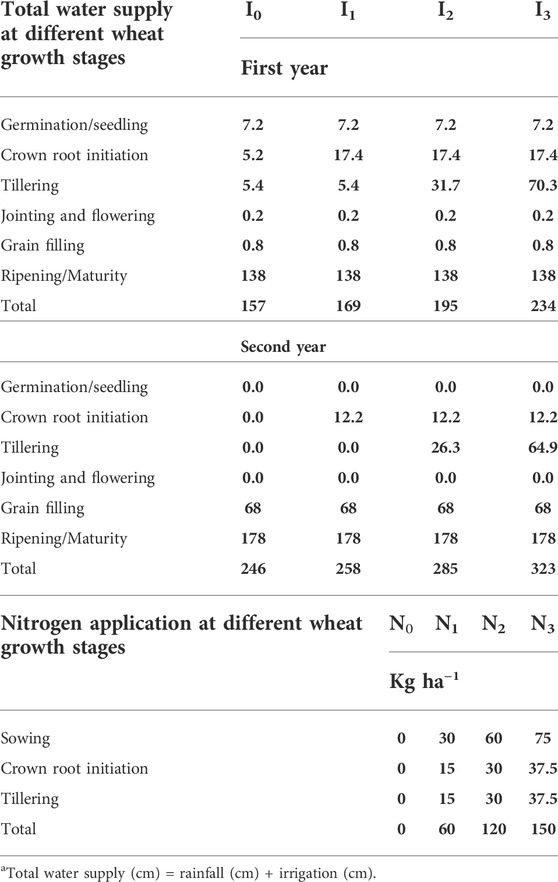
TABLE 2. Total water supplya (cm) and nitrogen application during the growth period of wheat crop for 2 years of the study.
Crop management practice
In both the years, the wheat variety HD-2967 was sown with a seed rate of 100 kg ha−1 in the last week of November and harvested in the last week of April. The seeds were treated with chloropyriphos (20 EC, 400 ml per 100 kg seeds mixed in 5 L of water) to control termite attacks. After the preceding rice crop, the application of glyphosate at 2.0 kg a.i. ha−1 was carried out 7 days before sowing. A pre-emergence application of pendimethalin at 0.50 kg a.i. ha−1 was carried out. Sowing of wheat was performed using the zero-till seed-cum-fertilizer drill. Fifty per cent of the total amount of N, full doses of P and K, and half of the total amount of fertilizer N were applied in different treatments at the time of sowing. At 21 DAS, 25% of the total amount of N was applied as the first top dressing. Remaining 25% of the total amount of N was applied as a second top dressing at 42 DAS followed by irrigation. A complex fertilizer (NPK 10:26:26) was used as the source of N, P, and K at the time of sowing through the zero-till machine, and to compensate the required amount of N and K, the difference was supplemented with urea and muriate of potash, respectively. The top dressings for N were carried out through urea.
The application of 2, 4-D at 0.50 kg a.i. ha−1 was performed after 35 DAS to kill the broad-leaved weeds. Application of boron was also performed after 35 and 55 days of sowing as borax (20% boron) at 1 g L−1 in all the plots. The four levels of irrigation applied were no irrigation water (I0), one irrigation water at 21 DAS (I1), two irrigations at 21 and 42 DAS (I2), and three irrigations at 21, 42, and 84 DAS (I3) as per specified treatment plots. The irrigation was applied through the pipe from a point source to every individual plot, and the amount of irrigation was measured using a flow meter installed at the end of the pipe. At 80% maturity, plants were harvested manually from each treatment plot.
Collection of soil and plant samples
Composite soil samples were collected from individual treatment plots from the experiment at 0–15, 15–30, 30–60, and 60–90 cm depths, both before sowing and immediately after the harvest of wheat crop in both the years. Sub-samples drawn from five cores for each depth of the individual treatment plots were pooled together as one composite soil sample for each treatment. Soil samples were air-dried at room temperature, ground in a wooden mortar, sieved through a 2-mm sieve, and preserved with care in air-tight polythene containers until the analysis was carried out. Data in the figures of the soil depth have been represented for 0–15, 15–30, 30–60, and 60–90 cm as 15, 30, 60, and 90 cm, respectively.
At maturity, wheat plants were harvested at the ground level from three locations each of 1 m2 area in the individual treatment plots. The harvested plants were separated into grain and straw after threshing, and yields were recorded. After thoroughly mixing, grain and straw samples, each of about 100 g by weight, were first washed with tap water repeatedly followed by washing with the distilled water and 0.1 N HCl and finally with distilled water. After air-drying, the samples were oven-dried at 60°C until a constant weight was obtained. The oven-dried samples were ground using a Willey Mill grinder and stored properly in a plastic container until the analysis was carried out. The grain yield was expressed as a 12% moisture level, while the straw yield at maturity as well as the biomass yield at growth stages was expressed on an oven-dry basis.
Soil analysis
The pH of the soil suspension (1:2) was measured potentiometrically by using a glass electrode-pH meter (Jackson, 1973). The bulk density was determined using a steel core of 100 cm3 (5 cm diameter and 5 cm height of small rings) following the procedure described by Blake. (1965).
The particle size analysis was determined by following the international pipette method (Piper, 1966). The rapid titration method of Walkely and Black, (1934) was used for the determination of oxidizable organic carbon of the soil samples. Mineral nitrogen (min-N) of the soil was estimated following the method of Keeney and Bremner, (1966). Nitrate-nitrogen (NO3-N) of soil samples was estimated following the procedure of Cataldo et al. (1975). The total N content in soil and plant samples was determined by the digestion and distillation procedure described by Kenny and Bremner, (1966).
Computations
• Soil water storage (Liu W. et al., 2018)
where soil water storage is expressed in cm, gravimetric water content in g g−1, bulk density in g cm−3, and soil depth in cm.
• Soil nitrate-nitrogen (NO3-N) accumulation (Liu W. et al., 2018)
where soil nitrate-N accumulation is expressed in kg ha−1, soil nitrate-N content in mg kg−1, bulk density in Mg m−3, and soil depth in m.
• Agronomic efficiency (AE)
where GYi = grain yield at the Ni level of N fertilizer (i = 0, 60, 120, 150 kg ha−1); GY0 = grain yield at the N0 level of N fertilizer.
• Physiological efficiency (PE)
where NUPi = plant N uptake (grain + straw) at the Ni level of nitrogen; NUP0 = plant N uptake (grain + straw) at the N0 level of nitrogen.
• Apparent N recovery (%)
where Nf = N uptake from a fertilized plot (kg ha−1), Nc = N uptake from control (kg ha−1), and F = total amount of fertilizer N applied (kg ha−1).
• Nutrient uptake: the uptake of N by grain or straw was computed using the grain or straw yield and concentrations of N.
Statistical analysis
The data generated from the study were analyzed for ANOVA for the split-plot design. The significance level was estimated using DMRT at p < 0.05 using Genstat software. The analyzed data were represented through graphs and tables. The interaction effects (irrigation levels and N levels) were shown at the 5% probability level.
Results
Grain and straw yield
The application of two or three irrigations to wheat (I2 and I3) resulted in the production of significantly higher grain yield of wheat than when only one irrigation was applied (I1) or the crop was grown under rain-fed conditions (Figure 3). In fact, the increase in the wheat yield was proportionate to the amount of irrigation water applied; the yield increase in treatments I3, I2, and I1 over I0 was 31.5%, 21%, and 12.6%, respectively (Figure 3). The wheat grain yield was found significantly greater at 120 and 150 kg N ha−1 (N2 and N3) than when either no N was applied (N0) or at 60 kg N ha−1 (N1) (Figure 3). The wheat grain increases were 177% and 171% over N0 when N3 (150 kg N ha−1) and N2 (120 kg N ha−1) were applied. An interaction effect of irrigation and N was also found to be significant at p < 0.05 (Figure 3). The highest grain yield was recorded in I3N2 treatment and the lowest in I0N0 treatment. The treatment I2N2 was statistically at par with I0N0.
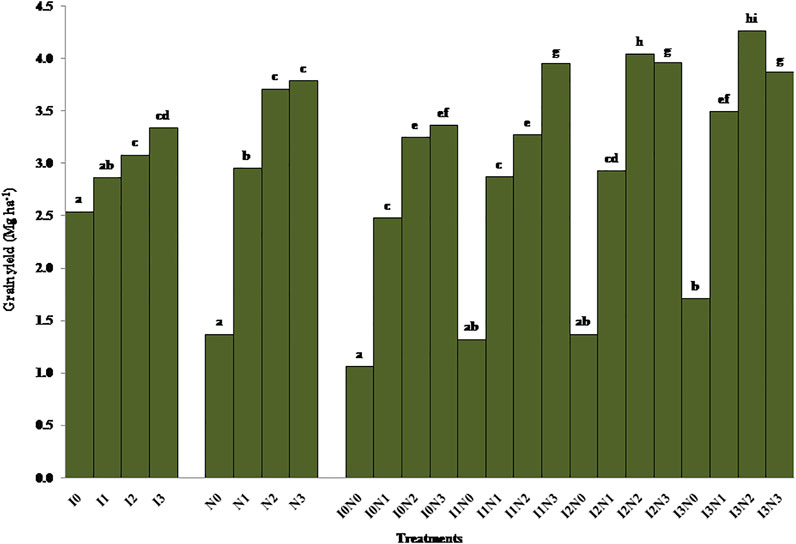
FIGURE 3. Effect of irrigation and nitrogen levels on the grain yield under zero-tilled wheat crop of the Terai agro-ecological zone in eastern India (pooled analysis) (means of similar lowercase letters are not significant at p < 0.05 based on DMRT).
Like the grain yield, the straw yield of wheat was significantly affected by both irrigation and N levels. The straw yield was significantly higher at I2 and I3 irrigation levels than the rain-fed conditions (no irrigation or I0). The straw yield was at par with I2 and I3 irrigation levels (Figure 4). The maximum straw yield was obtained in the treatment I3. The highest straw yield increase was at the tune of 28% in I3 treatment followed by 18% in I2 and 6.4% in I1 over I0 (Figure 4). Among N levels, the straw yield was found significantly higher at 120 and 150 kg N ha−1 (N2 and N3) than no N application (N0) or 60 kg N ha−1 (N1) (Figure 4). The wheat straw increases were 131% and 130% over N0 when N3 (150 kg N ha−1) and N2 (120 kg N ha−1) were applied (Figure 4). The interaction effect of irrigation and N was not significant at p < 0.05 (Figure 4).
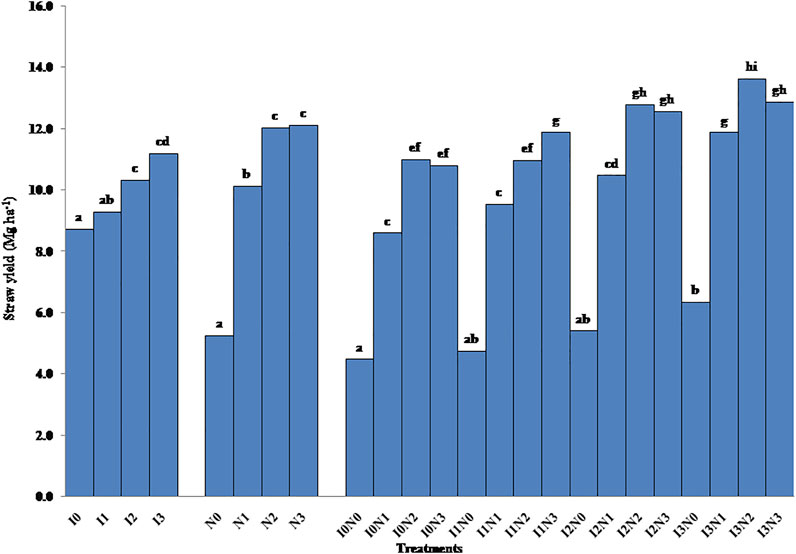
FIGURE 4. Effect of irrigation and nitrogen levels on the straw yield under zero-tilled wheat crop of the Terai agro-ecological zone in eastern India (pooled analysis) (means of similar lowercase letters are not significant at p < 0.05 based on DMRT).
Nitrogen uptake by wheat crop
The trend of N uptake was similar to that of the grain yield and was significantly affected by irrigation and N levels. Among the irrigation levels, N uptake was significantly higher at I2 and I3 levels than I0 (Figure 5). The N uptake varied significantly among the N treatments, and this variation followed a descending trend; the highest N uptake was observed in N3 which was significantly higher than the other levels followed by I2> I1>I0 (Figure 5). The interaction effects of irrigation and N was found significant at p < 0.05 (Figure 5). The response of wheat to fertilizer N application followed the quadratic equation at all the irrigation levels (Figure 6).
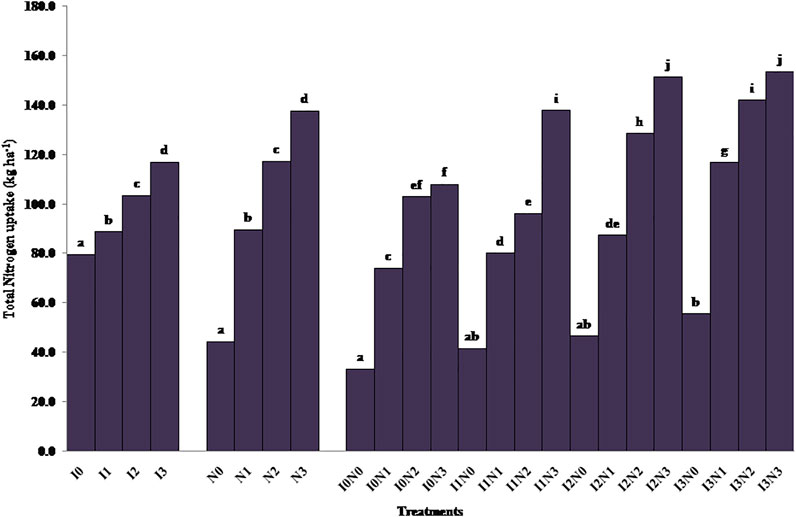
FIGURE 5. Effect of irrigation and nitrogen levels and total nitrogen uptake under zero-tilled wheat crop of the Terai agro-ecological zone in eastern India (pooled analysis) (means of similar lowercase letters are not significant at p < 0.05 based on DMRT).
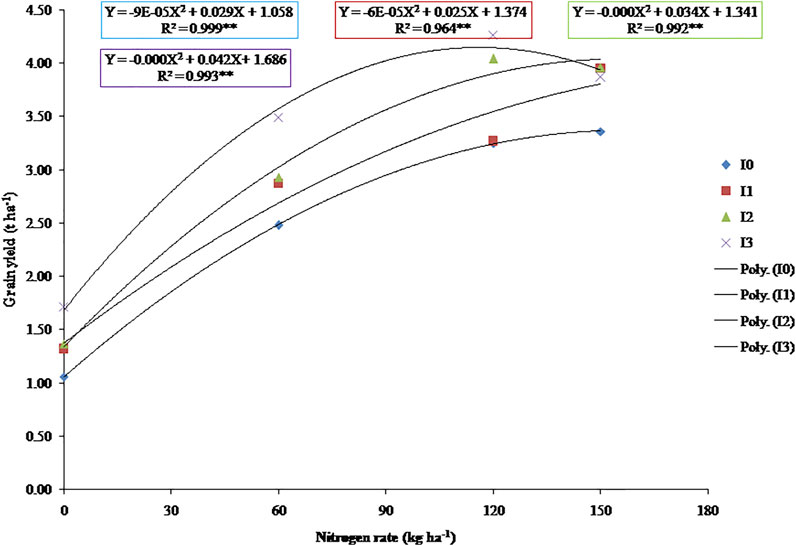
FIGURE 6. Grain yield as affected by nitrogen rates under four irrigation regimes after 2 years of pooled analysis.
Distribution of soil moisture in soil profiles
Soil moisture storage before sowing of wheat and after harvesting of wheat was studied up to 90 cm depth in the soil profile. Before sowing of wheat, the soil moisture content did not vary up to 60 cm depth. A small reduction in the soil moisture content was observed in the 60–90 cm soil layer. Although soil moisture in the soil profile kept on changing during the wheat season in response to different irrigation treatments, the soil moisture content at different layers after the harvest of wheat reflected the overall effect of growing the crop. The maximum soil moisture content after the harvest of wheat was recorded in the 0–15 cm soil layer; the minimum was observed in a soil depth of 15–30 cm. In the soil depth of 60–90 cm, the soil moisture content was more or less similar to that observed before sowing of wheat (Figure 7).
The soil water storage carried out at different crop growth durations (at sowing, 42 DAS, 84 DAS, and at maturity) under various irrigation regimes is shown in Figures 8A–D. There was not much variation among the irrigation regimes at sowing with increasing soil layers. However, at 42 DAS, 84 DAS, and at maturity, the variability was increased with increasing soil depths and irrigation regimes. Soil water storage was higher in the subsurface layers (30–90 cm) than the surface layer (0–15 cm) and subsurface layer (15–30 cm). At 42 DAS, among the irrigation regimes, the highest soil water storage was recorded in I3 followed by I2 and I1, and the lowest at I0. Among the soil depths, the highest soil water storage was observed at 60 cm followed by 90 cm, 15 cm, and then 30 cm. A similar trend was noted at 84 DAS and at maturity except at 84 DAS, the highest soil water storage was observed at 90 cm.
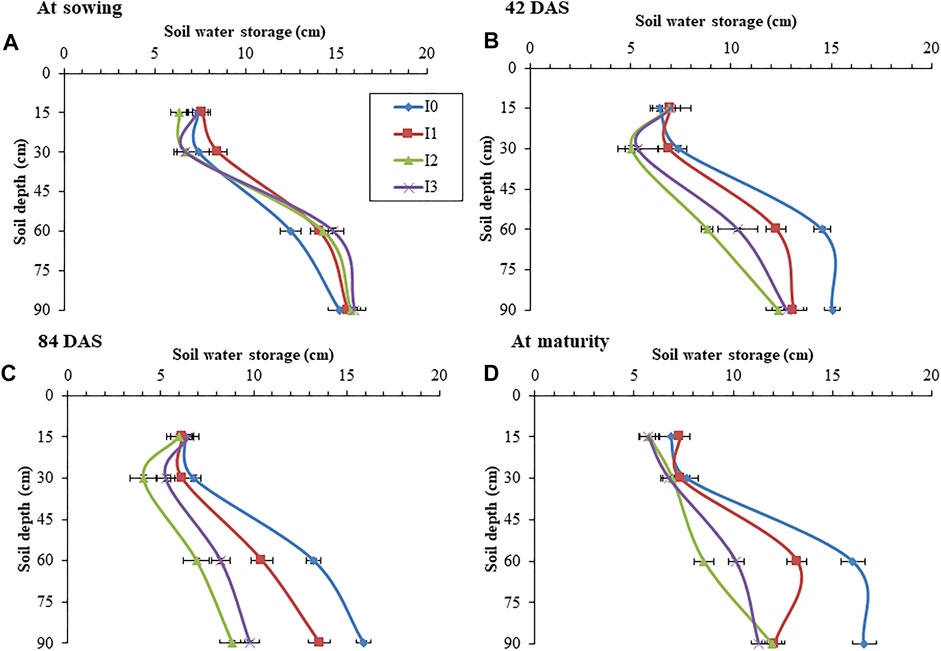
FIGURE 8. (A–D) Effect of irrigation and nitrogen regimes on soil water storage at different times and depths of sampling during the second year of study (mean ± standard error).
Distribution of nitrate-nitrogen (NO3-N) in the soil profile
The data pertaining to the distribution of NO3-N in the soil profile after the harvest of wheat crop are shown in Figures 9, 10. There was a decreasing trend in NO3-N accumulation up to 30 cm. After an increase up to 60 cm, a decrease in NO3-N was observed with an increasing soil depth up to 90 cm. A higher amount of NO3-N was accumulated in the 30–90 cm subsurface layer than in the 0–15 and 15–30 cm soil layers. The nitrate-N concentration before sowing of wheat was 4.6, 4.2, 4.0, and 3.3 mg kg−1 in the soil depths 0–15, 15–30, 30–60, and 60–90 cm, respectively (Table 1). After harvesting of the wheat crop, the concentration of NO3-N was greater under higher irrigation regimes and N levels than at sowing or at lower levels of irrigation (I0 and I1) and fertilizer N levels (N0 and N1). Among the irrigation regimes and N levels, I3 and N3 had the highest NO3-N concentrations (Figures 9A,B). An interactive effect of irrigation regimes and N levels showed a similar trend (Figures 10A–D). Among all the treatment combinations, the maximum NO3-N concentration was recorded in the treatment I2N2 (7.89 mg kg−1).
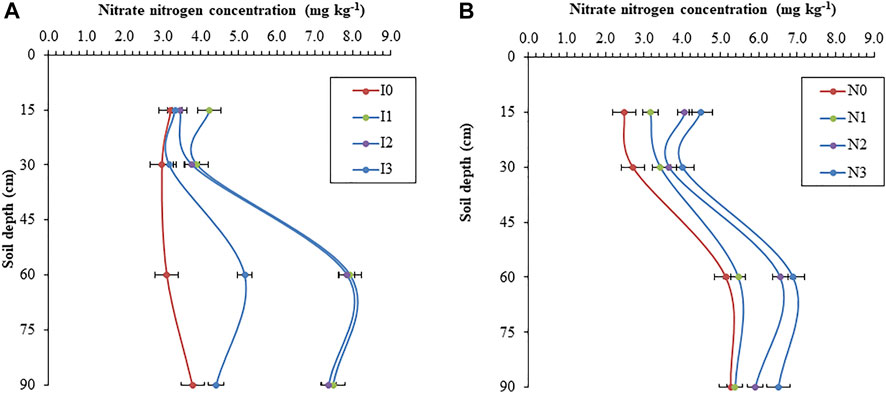
FIGURE 9. (A,B) Effect of different irrigation regimes and nitrogen levels on the nitrate-nitrogen concentration in the soil profile (0–90 cm) after the harvest of wheat crops (mean ± standard error).
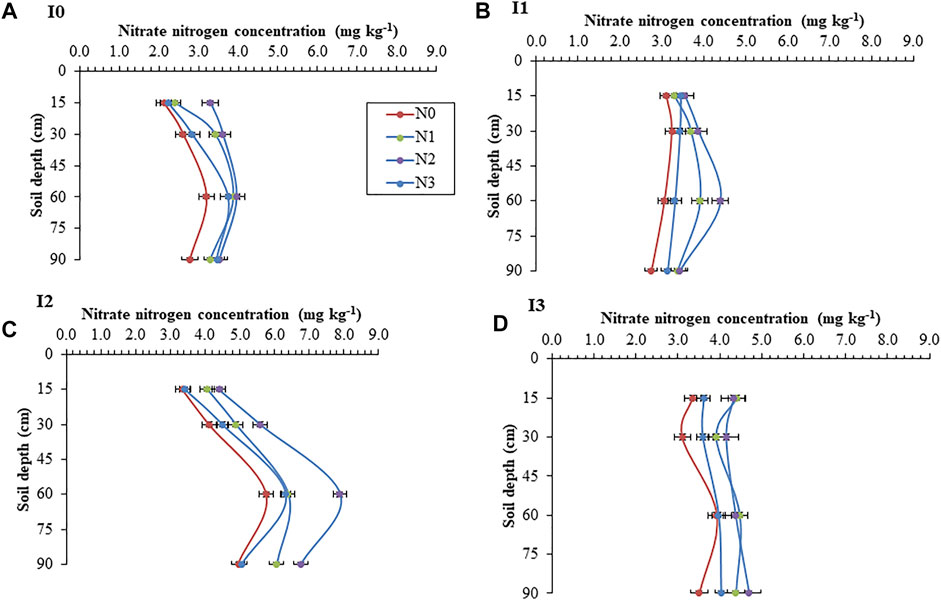
FIGURE 10. (A–D) Effect of different irrigation regimes and nitrogen levels on the nitrate-nitrogen concentration in the soil profile (0–90 cm) after the harvest of wheat crops (mean ± standard error).
Accumulation of nitrate-nitrogen (NO3-N) in the soil profile
The amount of NO3-N in the composite soil sample before sowing of wheat crop in the first year was 49.14 kg N ha−1 in the soil profile (0–90 cm). After harvesting of the crop, the accumulation of NO3-N to the application of different irrigation levels showed that the NO3-N content was significantly increased up to I2 and further declined at I3 over the control (I0); however, the treatments I2 and I3 were at par (Figure 11). The application of fertilizer N also significantly increased the accumulation of NO3-N.
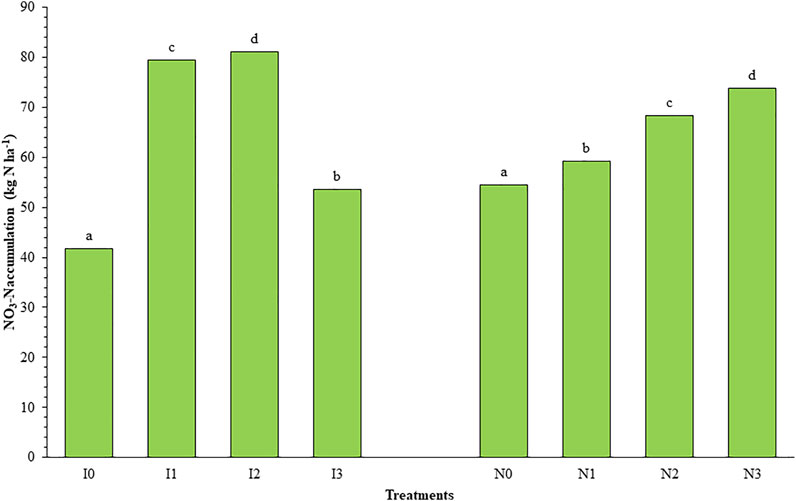
FIGURE 11. Effect of different irrigation regimes and nitrogen levels on the nitrate-nitrogen accumulation in the soil profile (0–90 cm) after the harvest of wheat crops (pooled analysis) (means of similar lowercase letters are not significant at p < 0.05 based on DMRT).
Nitrogen-use efficiencies
The data pertaining to NUE in wheat as influenced by irrigation and fertilizer N application are presented in Table 3. Application of the increasing amount of irrigation did not significantly affect AE and PE; however, increasing the level of irrigation from I1 to I2 reduced the ANR significantly but a further increase in irrigation levels did not affect ANR. The maximum ANR was recorded in the treatment I1 (0.45). Increasing the level of N increased the NUE (Table 4). Increasing the doses of N decreased AE. The maximum AE was obtained in the treatment N1 followed by N2 and N3. A similar trend was observed in ANR. However, PE reached maximum at N1 but at par with N2 and minimum in the treatment N3 (Table 4). The combined applications of irrigation and N had a positive and significant influence on AE and ANR but had no significant effect on PE (Table 3).
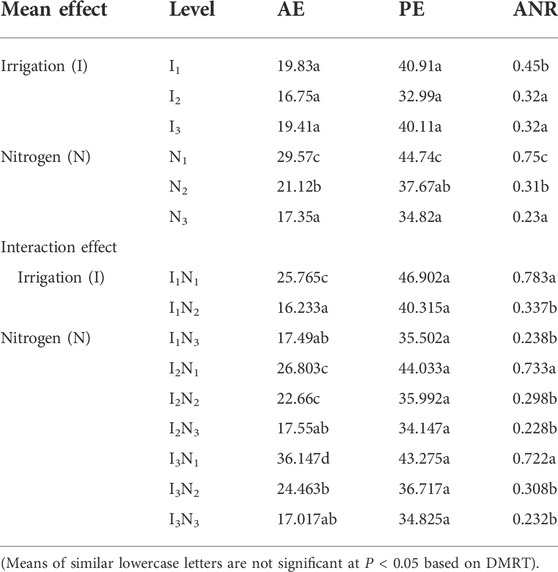
TABLE 3. Agronomic efficiency (AE), physiological efficiency (AE), and apparent nitrogen recovery (ANR) in wheat crops (pooled analysis).
Relationship between parameters
Increasing the irrigation supply to wheat had a positive and significant relationship with grain yield, straw yield, total N uptake, and NO3-N accumulation (Table 4). The grain yield as influenced by the irrigation levels was correlated with total N uptake in a positive and highly significant (p < 0.01) manner. The grain yield was also significantly correlated with NO3-N accumulation as influenced by irrigation levels at p < 0.05. The grain yield as influenced by N levels was positively and significantly correlated with total N uptake as influenced by N application; however, it was negatively and significantly correlated with a total water reserve at p < 0.05 (Table 4).
Discussion
Yield and nitrogen uptake
Nitrogen is one of the indispensable plant nutrients that affect productivity and water-use efficiency (Wang et al., 2015). Large yield increases in N-fertilized plots in comparison to no-N plot were due to the sandy loam texture along with a low fertility status of the soils which showed a positive response to increasing fertilizer N application (Sun et al., 2020).
In the IGP, wheat is grown in the winter (Rabi season) just after harvesting of rice. The residual soil moisture after rice harvest is limited/deficit to meet the water demand during the complete life cycle of the wheat crop. Supplemental irrigation is required to sustain crop growth and maximize the wheat yield. An optimal N supply along with suitable irrigation is essential to achieve high-yield levels of wheat (Pandey et al., 2001; Jat et al., 2014; Rathore et al., 2021). At any given level of irrigation or water supply, the yield of wheat increases with the increasing fertilizer N level only up to a point (Jat et al., 2014). However, with an increasing irrigation level, N uptake in response to application of fertilizer N increased up to a higher fertilizer N level. Prihar et al. (1981) and Gajri et al. (1993) observed highly positive interactions among the total water supply (stored water, seasonal rainfall, and irrigation) to wheat and N supply. It was found that an increase in the yield with the simultaneous increase in irrigation supply and fertilizer N was almost twice the sum of the increase in irrigation and N alone. A reduced extraction of water from deep soil layers by wheat receiving adequate N fertilizers and increased evapotranspiration in irrigated wheat (Gajri et al., 1993) supports that the positive interaction effects between irrigation and N fertilizers are mediated through effects of N and/or water supply on root and shoot growth of wheat. In the present study, the combined applications of irrigation and N resulted in the highest grain yield in the I2N2 treatment (two irrigations and 120 kg N ha−1). Likewise, grain yield, straw yield, and total N uptake were significantly increased from 10.11 Mg ha−1 to 12.09 Mg ha−1 and 89.51 kg ha−1 to 137.57 kg ha−1, respectively, with an increasing N rate from 60 to 150 kg ha−1. Fertilizer N had a significant role in the straw yield and total N uptake of wheat crop and followed the same trend with the irrigation levels. Due to the irrigation application (I3), there was an increase in the biomass yield (28%) which also resulted in a higher N uptake (47%) than the control. The increase in straw and N uptake due to the increasing N level resulted from the improvement in N availability in the soil and increased leaf photosynthesis (Echarte et al., 2008). Similar results were obtained by Sepaskhah and Hosseini (2008) and Astaoui et al. (2021) on wheat crops. According to them, N application has a direct influence on grain and straw yields of wheat by increasing the level of N in the soil.
Accumulation of nitrate-nitrogen in the soil profile
Accumulation of NO3-N in the soil profile was found to be greatly influenced by N and irrigation regimes. Unwarranted N application and irrigation increased residual soil NO3-N once wheat was harvested (Wang et al., 2015). In this study across the levels of irrigation, accumulation of NO3-N was the highest in the second level of irrigation (I2) and further decreased on a higher level of irrigation level (I3) in the acidic alluvial soil. A higher amount of NO3-N was obtained in the soil at the I2 level of irrigation and N3 level of fertilizer N (120 kg N ha−1). The medium irrigation level had higher values of NO3-N accumulation than high irrigation, and this observation was similar to Wang et al. (2010) and Liu et al. (2018a). The NO3-N accumulation gradually decreased with higher levels of irrigation as well as N. The combined application of irrigation water and N rates significantly influenced the NO3-N concentration after the harvest of wheat crops. The highest concentration (7.89 mg kg−1) of NO3-N was observed due to the treatment I2N2 after the harvest of wheat crops. The lowest concentration was observed in the I0N0 treatment. Similar results were observed by Jalali (2005), Fan et al. (2010), and Liu et al. (2018b) in wheat crops, and they found a positive relationship between N levels and NO3-N concentration and accumulation in the different soil layers. They also reported low NO3-N leaching in N < 150 kg N ha−1. However, the accumulation of NO3-N increased with heavy doses of N (>225 kg ha−1). An excessive supply of irrigation increases the risk of leaching NO3-N and deposition in the soil (Casey et al., 2002; Mahmud et al., 2021). Therefore, N applied at an optimum rate can help minimize leaching losses of NO3-N. The maximum concentration and accumulation of NO3-N were recorded in the subsurface soil layer at 60 cm.
Nitrogen-use efficiency
High NUE in a crop can be achieved by applying optimum levels of N and by maintaining soil moisture leading to an increase in N uptake by the crop (Giller et al., 2004; Ding et al., 2018). In the present investigation, NUE varied among the treatments, but different levels of irrigation did not affect the use efficiencies significantly; however, AE and PE were higher in the I1 treatment than other treatments. Ballester et al. (2021) observed that N uptake efficiency and N accumulation in grains with no irrigation were lower than those in the irrigation treatments, and resulted in a lower grain yield, but the NUE values were higher in the no-irrigation treatment. Among all levels of N, AE and PE were the highest at a lower dose of N (N1) and decreased with the increasing N levels. Excessive N application under sufficient irrigation could cause N leaching and reduced NUE (Li et al., 2019). Majeeed et al. (2015) reported that reduced N losses and consequent higher NUE in wheat were observed due to a lower N level. A significant interaction between irrigation and N management in the study revealed that better AE and PE were observed under the treatment of N1I3 followed by N1I2. Therefore, the application of water improved the utilization of N by the wheat crop in the present scenario. An analysis for the ANR showed significant variations among the N treatments at all levels of irrigation. The significant differences of ANR were observed between N levels. Pradhan et al. (2013) reported similar results about ANR in wheat and found that at the N1 level ANR was higher than all other treatments because there was no leaching below the root zone. Lenka et al. (2013) reported a reduction in ANR in wheat crop with an increase in the fertilizer dose. A similar finding was also reported by Yang et al. (2019) who observed that the N application significantly increased the grain yield, whereas there was a significant decrease in ANR in response to an increase in the N application rate. Moreover, the sandy loam texture of soil influenced the water and N effect on other treatments. The reduction in ANR with an increasing dose may be attributed to more leaching and volatilization losses of N with the application of N being more than what the crop needs. The increase in ANR with three splits of N could be readily explained by more uptakes and less leaching losses of N (Lopez-Bellido et al., 2006). In the present study, ANR of wheat at 60 kg N ha−1 was significantly higher than at 120 kg N ha−1 and 150 kg N ha−1. This is mainly attributed to the losses of N at higher levels of N application and also due to the fact that the yield of wheat did not increase in the same proportion as that of N application. Similar results have been reported by many workers (Gajri et al., 1993; Bandyopadhyay et al., 2009; Chakrabarty et al., 2010; Pradhan et al., 2013; Pradhan et al., 2014). The highest ANR efficiency of 78% was recorded for 122 mm irrigation at an N rate of 60 kg ha−1 in the pooled data which was statistically at par with that of 263 and 386 mm irrigations at the same N level, while the lowest ANR (22%) was recorded from 263 mm irrigation at an N rate of 150 kg ha−1 which was statistically at par with that of 122 and 386 mm irrigations with the same N rate. Generally, ANR values ranging between 30%–50% and 50%–80% indicate a well-managed system (Gauer et al., 1992). Lu et al. (2021) reported that deficit irrigation with N fertilization is required for achieving higher grain yield, NUE, and reducing the risk of soil nitrate-N leaching in the winter wheat–summer maize rotation system. Therefore, only an appropriate dose of N supplemented with irrigation can affect the wheat productivity as well as NUE in the acidic alluvial soils in the eastern IGP.
Conclusion
In acidic alluvial soils in the eastern IGP of India, high-yield levels of wheat grown after the harvest of rice crops can be achieved by applying an appropriate rate and the right time of fertilizer N along with adequate irrigation. The right combination of fertilizer N and irrigation levels will also reduce the N leaching losses from the soil. The present investigation has revealed that by applying 120 kg N ha−1 in three split doses at sowing (50%), crown root initiation (25%), and tillering (25%) stages, along with irrigations at 21 and 42 DAS produced a high wheat yield with high NUE which also led to minimal losses of nitrate-N from the soil profile. The application of three irrigations and/or 150 kg N ha−1 will lead to low NUE, more losses of N via leaching, and no further significant increase in the yield.
Data availability statement
The original contributions presented in the study are included in the article/Supplementary Material; further inquiries can be directed to the corresponding authors.
Author contributions
AKS framed the notion and was overall in charge of this manuscript preparation. SS, PM, PMB, and RP collected the literature, analyzed the data, and drafted the manuscript. RK prepared the map. BS, BP, AV, AK, BY, SB, AK, MK, and UK edited the manuscript. All contributors discussed the outcomes and added to the final document. All authors have studied and approved the in-print version of the manuscript.
Acknowledgments
The authors gratefully acknowledge the support in terms of experimental facilities extended by the Department of Soil Science and Agricultural Chemistry, UBKV, Pundibari (Cooch Behar).
Conflict of interest
The authors declare that the research was conducted in the absence of any commercial or financial relationships that could be construed as a potential conflict of interest.
Publisher’s note
All claims expressed in this article are solely those of the authors and do not necessarily represent those of their affiliated organizations, or those of the publisher, the editors, and the reviewers. Any product that may be evaluated in this article, or claim that may be made by its manufacturer, is not guaranteed or endorsed by the publisher.
References
Astaoui, G., Dadaiss, J. E., Sebari, I., Benmansour, S., and Mohamed, E. (2021). Mapping wheat dry matter and nitrogen content dynamics and estimation of wheat yield using UAV multispectral imagery machine learning and a variety-based approach: Case study of Morocco. AgriEngineering 3 (1), 29–49. doi:10.3390/agriengineering3010003
Awaad, M., and Deshesh, T. (2019). Wheat growth and nitrogen use efficiency under drip irrigation on semi-arid region. Eurasian J. Soil Sci. (EJSS) 8, 229–236. doi:10.18393/ejss.566537
Ballester, C., Hornbuckle, J., Brinkhoff, J., and Quayle, W. C. (2021). Effects of three frequencies of irrigation and nitrogen rates on lint yield, nitrogen use efficiency and fibre quality of cotton under furrow irrigation. Agric. Water Manag. 248, 106783. doi:10.1016/j.agwat.2021.106783
Bandyopadhyay, K. K., Prakash, A. H., Sankaranarayanan, K., Dharajothi, B., and Gopalakrishnan, N. (2009). Effect of irrigation and nitrogen on soil water dynamics, productivity and input-use efficiency of Bt cotton (Gossypium hirsutum) in a Vertic Ustropept. Indian J. Agric. Sci. 79 (6), 448–453.
Bhatt, R., Kukal, S. S., Busari, M. A., Arora, S., and Yadav, M. (2016). Sustainability issues on rice–wheat cropping system. Int. Soil Water Conservation Res. 4, 64–74. doi:10.1016/j.iswcr.2015.12.001
Bijay-Singh, , and Craswell, E. (2021). Fertilizers and nitrate pollution of surface and ground water: An increasingly pervasive global problem. SN Appl. Sci. 3, 1–24. doi:10.1007/s42452-021-04521-8
Biswas, S. (2016). Patterns of nitrogen mineralization under two water regimes in an acidic Entisols as influenced by chemical composition of plant residues. India: Cooch Behar. Ph.D. dissertation. U.B.K.V., Pundibari.
Blake, G. R. (1965). “Physical and mineralogical properties, including statistics of measurement and sampling,” in Methods of soil analysis, Part 1. ASA-SSSA, agronomy monograph. Editor C. A. Black, 9, 374–390. doi:10.2134/agronmonogr9.1.c30
Casey, F. X. M., Derby, N., Knighton, R. E., Steele, D. D., and Stegman, E. C. (2002). Initiation of irrigation effects on temporal nitrate leaching. Vadose Zone J. 1, 300–309. doi:10.2113/1.2.300
Cataldo, D. A., Maroon, M., Schrader, L. E., and Youngs, V. L. (1975). Rapid colorimetric determination of nitrate in plant tissue by nitration of salicylic acid. Commun. Soil Sci. Plant Anal. 6 (1), 71–80. doi:10.1080/00103627509366547
Chakrabarty, D., Garg, R. N., Tomar, R. K., Singh, R., Sharma, S. K., Singh, R. K., et al. (2010). Synthetic and organic mulching and nitrogen effect on winter wheat (Triticum aestivum L.) in a semiarid environment. Agric. Water Manag. 97, 738–748. doi:10.1016/j.agwat.2010.01.006
Ding, J., Li, F., Le, T., Xu, D., Zhu, M., Li, C., et al. (2021). Tillage and seeding strategies for wheat optimizing production in harvested rice fields with high soil moisture. Sci. Rep. 11, 119. doi:10.1038/s41598-020-80256-7
Ding, W., Xu, X., He, P., Ullah, S., Zhang, J., Cui, Z., et al. (2018). Improving yield and nitrogen use efficiency through alternative fertilization options for rice in China: A meta-analysis. Field Crops Res. 227, 11–18. doi:10.1016/j.fcr.2018.08.001
Echarte, L., Rothstein, S., and Tollenaar, M. (2008). The response of leaf photosynthesis and dry matter accumulation to nitrogen supply in an older and a newer maize hybrid. Crop Sci. 48 (2), 656–665. doi:10.2135/cropsci2007.06.0366
Fan, J., Hao, M., and Malhi, S. S. (2010). Accumulation of nitrate N in the soil profile and its implications for the environment under dryland agriculture in northern China: A review. Can. J. Soil Sci. 90, 429–440. doi:10.4141/CJSS09105
Gajri, P. R., Prihar, S. S., and Arora, V. K. (1993). Interdependence of nitrogen and irrigation effects on growth and input-use efficiencies in wheat. Field Crops Res. 31, 71–86. doi:10.1016/0378-4290(93)90051-n
Gauer, L. E., Grant, C. A., Gehl, D. T., and Bailey, L. D. (1992). Effects of nitrogen fertilization on grain protein content, nitrogen uptake, and nitrogen use efficiency of six spring wheat (Triticum aestivum L.) cultivars, in relation to estimated moisture supply. Can. J. Plant Sci. 72, 235–241. doi:10.4141/cjps92-026
Geesing, D., Diacono, M., and Schmidhalter, U. (2014). Site-specific effects of variable water supply and nitrogen fertilisation on winter wheat. J. Plant Nutr. Soil Sci. 177, 509–523. doi:10.1002/jpln.201300215
Giller, K. E., Chalk, P., Dobermann, A., Hammond, L., Heffer, P., Ladha, J. K., et al. (2004). “Emerging technologies to increase the efficiency of use of fertilizer nitrogen,” in Agriculture and the Nitrogen Cycle: Assessing the Impacts of Fertilizer use on Food Production and the Environment. Editors R. Arvin, J. Mosier, K. Syers, and R. F. John. SCOPE 65. Washington, DC: Island Press, 35–51.1559637102
Jackson, M. L. (1973). Soil chemical analysis. 2nd Edition. New Delhi: Prentice Hall of India Pvt. Ltd, 111–204.
Jalali, M. (2005). Nitrates leaching from agricultural land in Hamadan, Western Iran. Agric. Ecosyst. Environ. 110, 210–218. doi:10.1016/j.agee.2005.04.011
Jat, M. L., Bijay-Singh, , and Gerard, B. (2014). Nutrient management and use efficiency in wheat systems of South Asia. Adv. Agron. 125, 171–259. doi:10.1016/B978-0-12-800137-0.00005-4
Keeney, D. R., and Bremner, J. M. (1966). A Chemical index of soil nitrogen availability. Nature 211, 892–893. doi:10.1038/211892a0
Lenka, S., Singh, A. K., and Lenka, N. K. (2013). Soil water and nitrogen interaction effect on residual soil nitrate and crop nitrogen recovery under maize–wheat cropping system in the semi-arid region of northern India. Agric. Ecosyst. Environ. 179, 108–115. doi:10.1016/j.agee.2013.08.001
Li, J. P., Wang, Y. Q., Zhang, M., Liu, Y., Xu, X. X., Lin, G., et al. (2019). Optimized micro-sprinkling irrigation scheduling improves grain yield by increasing the uptake and utilization of water and nitrogen during grain filling in winter wheat. Agric. Water Manag. 211, 59–69. doi:10.1016/j.agwat.2018.09.047
Liu, W., Ma, G., Wang, C., Wang, J., Lu, H., Li, S., et al. (2018a). Irrigation and nitrogen regimes promote the use of soil water and nitrate nitrogen from deep soil layers by regulating root growth in wheat. Front. Plant Sci. 9, 32. doi:10.3389/fpls.2018.00032
Liu, Z., Gao, F., Liu, Y., Yang, J., Zhen, X., Li, X., et al. (2018b). Timing and splitting of nitrogen fertilizer supply to increase crop yield and efficiency of nitrogen utilization in a wheat–peanut relay intercropping system in China. Crop J. 7, 101–112. doi:10.1016/j.cj.2018.08.006
López-Bellido, L., López-Bellido, R. J., and López-Bellido, F. J. (2006). Fertilizer nitrogen efficiency in durum wheat under rainfed mediterranean conditions: Effect of split application. Agron. J. 98 (1), 55–62. doi:10.2134/agronj2005.0017
Lu, J., Xiang, Y., Fan, J., Zhang, F., and Hu, T. (2021). Sustainable high grain yield, nitrogen use efficiency and water productivity can be achieved in wheat-maize rotation system by changing irrigation and fertilization strategy. Agric. Water Manag. 258, 107177. doi:10.1016/j.agwat.2021.107177
Luis, L. B., Rafael, J. L. B., and Ramon, R. (2005). Nitrogen efficiency in wheat under rainfed Mediterranean conditions as affected by split nitrogen application. Field Crops Res. 94, 86–97. doi:10.1016/j.fcr.2004.11.004
Mahmud, K., Panday, D., Mergoum, A., and Missaoui, A. (2021). Nitrogen losses and potential mitigation strategies for a sustainable agroecosystem. Sustainability 13 (4), 2400. doi:10.3390/su13042400
Majeed, A., Muhmood, A., Niaz, A., Javid, S., Ahmad, Z., Shah, S., et al. (2015). Bed planting of wheat (Triticum aestivum L.) improves nitrogen use efficiency and grain yield compared to flat planting. Crop J. 3 (2), 118–124. doi:10.1016/j.cj.2015.01.003
Marković, M., Šoštarić, J., Josipović, M., and Atilgan, A. (2021). Extreme weather events affect agronomic practices and their environmental impact in maize cultivation. Appl. Sci. (Basel). 11 (16), 7352. doi:10.3390/app11167352
Pandey, R. K., Maranville, J. W., and Admou, A. (2001). Tropical wheat response to irrigation and nitrogen in a Sahelian environment. I. Grain yield, yield components and water use efficiency. Eur. J. Agron. 15, 93–105. doi:10.1016/S1161-0301(01)00098-3
Pradhan, S., Bandyopadhyay, K. K., Sahoo, R. N., Sehgal, V. K., Singh, R., Joshi, D. K., et al. (2013). Prediction of wheat (Triticum aestivum) grain and biomass yield under different irrigation and nitrogen management practices using canopy reflectance spectra model. Indian J. Agric. Sci. 83, 1136–1143. ISSN: 0019-5022.
Pradhan, S., Chopra, U. K., Bandyopadhyay, K. K., Singh, R., Jain, A. K., and Chand, I. (2014). Effect of deficit irrigation and nitrogen levels on water productivity and nitrogen use efficiency of wheat (Triticum aestivum) in a semi-arid environment. Indian J. Agric. Sci. 84, 887–891. ISSN: 0019-5022.
Prem, G., Kumar, A., Singh, V. K., and Kumar, R. (2018). Performance of front-line demonstration on Zero Tillage wheat sowing in ambala district of Haryana, India. Asian J. Agric. Ext. Econ. Sociol. 26 (4), 1–6. doi:10.9734/AJAEES/2018/42958
Prihar, S. S., Sandhu, K. S., Singh, Y., and Singh, R. (1981). Effect of N-rates on dryland wheat in relation to mulching previous crop or fallow. Fert. Res. 2, 211–219. doi:10.1007/BF01834814
Rasmussen, I. S., Dresbøll, D. B., and Thorup-Kristensen, K. (2015). Winter wheat cultivars and nitrogen (N) fertilization-effects on root growth, N uptake efficiency and N use efficiency. Eur. J. Agron. 68, 38–49. doi:10.1016/j.eja.2015.04.003
Rathore, V. S., Nathawat, N. S., Bhardwaj, S., Yadav, B. M., Kumar, M., Santra, P., et al. (2021). Optimization of deficit irrigation and nitrogen fertilizer management for peanut production in an arid region. Sci. Rep. 11, 5456. doi:10.1038/s41598-021-82968-w
Saini, H. S. (2008). Climate change and its future impact on the Indo-Gangetic Plain (IGP). Earth Sci. India 301 1 (3), 138–147.
Sekar, I., and Pal, S. (2012). Rice and wheat crop productivity in the Indo-gangetic plains of India: Changing pattern of growth and future strategies. Indian J. Agric. Econ. 67, 238–252. doi:10.22004/ag.econ.204809
Sepaskhah, A. R., Azizian, A., and Tavakoli, A. R. (2006). Optimal applied water and nitrogen for winter wheat under variable seasonal rainfall and planning scenarios for consequent crops in a semi-arid region. Agric. Water Manag. 84, 113–122. doi:10.1016/j.agwat.2006.01.008
Sinha, A. K. (2013). Phd thesis. Short term effect of tillage and residue management on soil characteristics and crop yields under the rice-wheat cropping system. India: U.B.K.V.Pundibari, Cooch Behar.
Sun, J., Li, W., Li, C., Chang, W., Zhang, S., Zeng, Y., et al. (2020). Effect of different rates of nitrogen fertilization on crop yield, soil properties and leaf Physiological Attributes in banana Under Subtropical regions of China. Front. Plant Sci. 11, 613760. doi:10.3389/fpls.2020.613760
Walkley, A., and Black, I. A. (1934). An examination of the Degtjareff method for determining soil organic matter, and a proposed modification of the chromic acid titration method. Soil Sci. 37 (1), 29–38. doi:10.1097/00010694-193401000-00003
Wang, Q., Li, F., Zhao, L., Zhang, E., Shi, S., Zhao, W., et al. (2010). Effects of irrigation and nitrogen application rates on nitrate nitrogen distribution and fertilizer nitrogen loss, wheat yield and nitrogen uptake on a recently reclaimed sandy farmland. Plant Soil 337, 325–339. doi:10.1007/s11104-010-0530-z
Wang, X., Shi, Y., Guo, Z., Zhang, Y., and Yu, Z. (2015). Water use and soil nitrate nitrogen changes under supplemental irrigation with nitrogen application rate in wheat field. Field Crops Res. 183, 117–125. doi:10.1016/j.fcr.2015.07.021
Yadav, A., Malik, R. K., Jaipal, S., Singh, S., Singh, R., Ram, K., et al. (2005). “Sustainability of long-term zero-tillage in wheat and its impact on the productivity of rice,” in Proceedings of Workshop on acceleration of resource conservation technology in rice-wheat systems of the Indo-Gangetic Plains (Accessed June 1–2, 2012) (India: Hisar), 23–31.
Yadav, A., Malik, R. K., Banga, R. S., Singh, S., Chauhan, B. S., Yadav, D. B., et al. (2002). “Long-term effects of zero tillage on wheat in rice-wheat cropping system,” in International workshop on herbicide resistance management and zero tillage in rice-wheat cropping system, 4–6 March, 2002 (India: Hisar), 158–161.
Keywords: irrigation, nitrogen rates, nitrogen-use efficiency, wheat yield, soil moisture, soil profile
Citation: Sahoo S, Mukhopadhyay P, Sinha AK, Bhattacharya PM, Rakesh S, Kumar R, Padbhushan R, Bijay-Singh , Parmar B, Vishwakarma A, Kumar A, Yadav BK, Bhushan S, Kumar A, Kaviraj M and Kumar U (2022) Yield, nitrogen-use efficiency, and distribution of nitrate-nitrogen in the soil profile as influenced by irrigation and fertilizer nitrogen levels under zero-till wheat in the eastern Indo-Gangetic plains of India. Front. Environ. Sci. 10:970017. doi: 10.3389/fenvs.2022.970017
Received: 15 June 2022; Accepted: 19 July 2022;
Published: 26 August 2022.
Edited by:
Rosa Francaviglia, Council for Agricultural and Economics Research (CREA), ItalyReviewed by:
Rakesh Kumar, ICAR-Research Complex for Eastern Region, IndiaBhabesh Gogoi, Assam Agricultural University, India
Copyright © 2022 Sahoo, Mukhopadhyay, Sinha, Bhattacharya, Rakesh, Kumar, Padbhushan, Bijay-Singh, Parmar, Vishwakarma, Kumar, Yadav, Bhushan, Kumar, Kaviraj and Kumar. This is an open-access article distributed under the terms of the Creative Commons Attribution License (CC BY). The use, distribution or reproduction in other forums is permitted, provided the original author(s) and the copyright owner(s) are credited and that the original publication in this journal is cited, in accordance with accepted academic practice. No use, distribution or reproduction is permitted which does not comply with these terms.
*Correspondence: Rajeev Padbhushan, cmFqcGQwMUBnbWFpbC5jb20=; Brajendra Parmar, YmlyanUxOTczQGdtYWlsLmNvbQ==; Upendra Kumar, dWt1bWFybWJAZ21haWwuY29t
 Samaresh Sahoo1
Samaresh Sahoo1 P. M. Bhattacharya
P. M. Bhattacharya Rajkishore Kumar
Rajkishore Kumar Rajeev Padbhushan
Rajeev Padbhushan Bijay-Singh
Bijay-Singh Brajendra Parmar
Brajendra Parmar Anand Vishwakarma
Anand Vishwakarma Amarendra Kumar
Amarendra Kumar Atul Kumar
Atul Kumar Megha Kaviraj
Megha Kaviraj Upendra Kumar
Upendra Kumar
